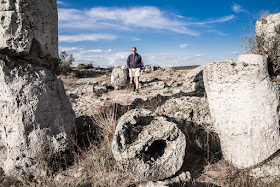We left Romania to travel along the coast to Bulgaria. We made a couple of interesting stops before we reached a lovely seaside resort.
The Ushakow monument commemorates the victory in the naval battle of Kaliakra in 1791 during the Russo-Turkish War in which a Turkish fleet was defeated by Russian warships under Admiral Fedor Ushakow. Each bell stands for one ship of the fleet.
Since antiquity there was a fortress at Cape Kaliakra. It was called by the Thracians Tirisis, under the Romans Akra and under the Byzantines Akres Kastelum. In the Middle Ages, the strategically important fortress was called Kaliakra. It became the capital of a Bulgarian kingdom in the 13th century under the despot Dobrotitsa.
In Balchik we stopped at the palace and beautiful gardens of Queen Marie of Romania. It was constructed on her request between 1926 and 1937 directly at the sea outside of Balchik. The official name of the palace was "Quiet Nest Palace". It consists of a number of residential villas, a smoking hall, a wine cellar, a power station, a monastery, a holy spring, a chapel and many other buildings, all of them situated in a park that is today a botanical garden.
 |
| Lovely interior |
 |
| Another visitor to the garden |
 |
| Jasmine flower |
Our next stop was at a place we had spotted on the map, called "Petrified forest". We looked it up and decided we had to see it.
Numerous theories and hypotheses still fail to offer a satisfactory explanation of how this "forest" was created. The prevailing opinion is that 50 million years ago there was a vast sea whose waves washed the foothills of the Alps. When the waters receded, the deposits were exposed to erosion. The rains washed away the loose earth and the solid parts, which the winds rounded in the course of millennia, remained upright giant desert stalactites that one sees today.
The columns are hollow and another theory says this are corals which grew where gas poured out of the seabed.
We passed through Varna again to travel further south to Obzor, a sea side resort from where we will visit Nesebar the next day.
 |
| Many flowers today :-) |



































